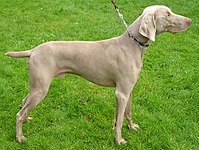
Photo from wikipedia
Introduction Many asthmatics remain symptomatic despite optimized medical therapy. New treatments are needed that are scalable at minimal cost. Pulmonary rehabilitation is established in respiratory disease, and emerging data suggests… Click to show full abstract
Introduction Many asthmatics remain symptomatic despite optimized medical therapy. New treatments are needed that are scalable at minimal cost. Pulmonary rehabilitation is established in respiratory disease, and emerging data suggests that prescribed exercise intervention may modulate the immune and inflammatory basis for asthma, offering clinical benefit beyond functional capacity improvement. High-intensity interval training (HIIT) seems better tolerated in asthmatics than constant work-rate training, but HIIT with strength training has not been assessed in terms of immunomodulatory potential, and mechanistic work is needed to explain these responses to exercise. Methods This study will randomise ten suboptimally controlled asthma patients to a 12 week HIIT Structured Responsive Exercise Training Programme (SRETP) or SRETP with strength training, which allows adaptation of the programme as fitness improves. Participants will be assessed at 3, 6 and 12 weeks to ascertain if SRETP is feasible, safe and tolerable, improves symptom control, modifies airway and systemic inflammation, and physiology in asthmatic patients. An interim analysis of the first 5 patients is presented. Results Early results suggest safety and tolerability. Wilcoxon signed rank tests between Baseline and Week 3 showed that ACQ score improved significantly (median=2.00 [IQR=1.82–2.38] vs median=1.50 [IQR=1.00–1.83], p=0.043). There were no statistically significant improvements in airways inflammation as assessed by FeNO (median=44.50 [IQR=29.00–87.25] vs median=49 [IQR=21.25–92.50], p=0.686), peripheral blood eosinophilia (n=4, median=0.30 [IQR=0.20–0.50] vs median=0.35 [IQR=0.30–0.48], p=0.102), or aerobic fitness as assessed by VO2 at anaerobic threshold (AT) (n=4, median=10.90 [IQR=9.55–20.25] vs 11.00 ml/kg/min [IQR=9.48–22.35]; p=0.285) and VO2peak (n=4, median=21.80 [IQR=17.15–33.45] vs 23.00 ml/kg/min [IQR=15.73–35.68]; p=0.465) Conclusion This interim data suggests even a very short period of exercise intervention is tolerated and beneficial for symptom control in sub-optimally controlled asthma. Further data will allow assessment of whether this precedes improvement in markers of inflammation, and current results are due to early subclinical cellular improvements in inflammation, or whether symptoms improve independent of any reduction in inflammation. We aim to further investigate this response to exercise training in asthma in a fully powered, observational mechanistic study. Prescribed exercise training programmes may provide a cost-effective treatment adjunct for suboptimally controlled asthmatics.
Journal Title: Thorax
Year Published: 2018
Link to full text (if available)
Share on Social Media: Sign Up to like & get
recommendations!